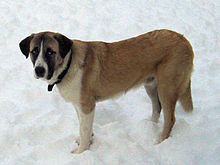Rafeiro do Alentejo

Rafeiro do Alentejo male
|
||||||||||||||||||
| Other names | Alentejo Mastiff, Portuguese Mastiff, Mutt of Alentejo | |||||||||||||||||
|---|---|---|---|---|---|---|---|---|---|---|---|---|---|---|---|---|---|---|
| Origin | Portugal | |||||||||||||||||
|
||||||||||||||||||
| Domestic dog (Canis lupus familiaris) | ||||||||||||||||||
| Classification / standards | |||
|---|---|---|---|
| FCI | Group 2, Section 2.2 Molossian: Mountain type #96 | standard | |
| AKC | |||
| The AKC Foundation Stock Service (FSS) is an optional recording service for purebred dogs that are not yet eligible for AKC registration. | |||
| UKC | Guardian Dog | standard | |
The Rafeiro do Alentejo or Alentejo Mastiff, also called the Portuguese Mastiff, is a large breed of dog that originated in Portugal. The Rafeiro do Alentejo is of the type, and the name refers to its area of origin, Alentejo, in south-central Portugal. Although the word rafeiro means mongrel in Portuguese, the Rafeiro do Alentejo is recognized as a breed by the Portuguese Caniculture Club and the Fédération Cynologique Internationale.
The Rafeiro is a very large mountain dog, averaging 47.5 kg (104.5 lb) and 73 cm (28.7 in) at the withers. The head is described as bear-like. Eyes should be dark, never yellow. The ears are set medium high and fold downwards. The dog has a deep chest, and should have a general aspect of length (not whippety, the standard says.) The fur is short to medium, the same length all over, and can be black, yellow, and fawn (a light brown colour) with white markings, or white with other colours. The coat can be streaked or brindled or dappled.
The breed standard describes the breed as "sober" (meaning "marked by seriousness, gravity, or solemnity of conduct"), his movement as slow and rolling, and as having a calm expression. Individual dogs may vary in behaviour and temperament, and puppies must be well socialized.
As with all very large dogs, they are not the dogs for beginners. Dogs of this size and type have the potential to be a danger to others if not well socialized at an early age, and are recommended only for the experienced dog handler who has the time to socialize and train the dog. They mature slowly, are very independent, and often does not respond to traditional force methods of dog obedience training. They are extremely territorial and will protect the sheep, households, and families they feel were placed under their protection. They are not aggressive but protective and are said to get along quite well with children.
Rafeiro do Alentejo are of the very ancient molosser type that migrated with humans from Central Asia. When the dogs arrived in the Iberian Peninsula is not known; they may have come with nomads sometime in prehistory, or have been brought by the Romans when they ruled the area thousands of years ago. It is often supposed that the breed is related to the Tibetan Mastiff, but no proof of this exists. Perhaps in the future, DNA evidence will prove when the dogs arrived and what their ancestry is, but for now there is no proof, only legends, guesswork, and speculation.
...
Wikipedia
